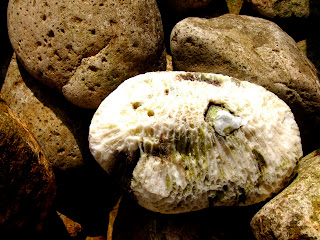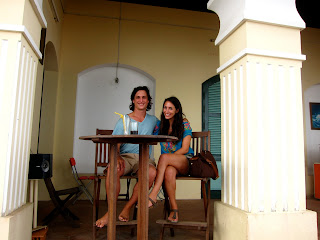Christmastime in Phang-nga began with a Christmas pageant at school.
And the Christmas pageant began with a break dancing troupe who performed to a Thai version of "Joy to the World."
Following the break dancing extravaganza was a ten minute version of the Nativity scene, complete with camels (foreground) and angels (background) the latter of whom subsequently performed a song and dance routine of equal length to the Nativity scene vignette to background music of a techno "Hark the Herald Angels Sing."
The best part of the Christmas pageant, besides the opportunity it afforded me to meet quite the cast of missionaries who happened to moonlight as the break dancers, was the post-Nativity performance. The break dancers were back, but split into two "teams," one of which was clad in the red sweatsuits and Mickey Mouse gloves of the "Joy to the World" group and the other of which was clad in all black sheets. Each group wielded a flag (red team's was white with an enormous red cross and the black team's was black and tattered). They separated into two teams and proceeded to have a dance off slash mock fight to music that can best be described as the opening bars of MJ's Thriller. As a Thai voice over proceeded to narrate the dance fight enfolding in front of the audience, a young Australian missionary who was visiting for the pageant gave me the translated version of the voice over. "They are Jesu Christ and Satan (pronounced "Saddan") and the man in the sunglasses is Father our God." Obviously.
After Satan punched Jesus, Father God showed up (he's hidden in the background) and punched Satan, at which point Jesu rose from the floor and the red team did a victory song and dance routine. After the routine, the dancer-missionaries handed out Thai English versions of the Bible.
The day after the Christmas Spectacular, I had one day of class before heading out on my trip to Vietnam. While working at my after school tutoring job, I happened upon this notebook which I found to be one of the stranger notebooks of my many years with notebooks. Disconnect between Thai and English languages/marketing skills? I think so.
After a quick 12 hour stop in Bangkok to step on American soil at the US Embassy (the arbitrary positioning of entry/exit stamps has really destroyed any rational layout to my passport), Steve and I flew to Ho Chi Minh City for the beginning of our ten day trip to Vietnam.
Pollution over Bangkok is terrifying.
Our flight to Con Dao left Ho Chi Minh City the following morning at the bleary hour of 5:50 AM so we arrived at Con Dao before 7 on Christmas Eve.
Early morning view from the street outside our hotel.
As our van drove around the rocky cliffs that constitute the island's shore we were offered spectacular views of towering mountains and vertical drops leading down to turquoise waves dotted with fishing boats.
We rented a motorbike and drove around the island whose scenery can best be described as the offspring of the Scottish countryside and a paradisaical beach.
Along the way we happened upon some beautiful ponds hidden amongst black stones and enormous chunks of coral.
The road continued around the island and after some rather precarious turns on unpaved roads with no side railings, we found ourselves driving alongside a drained body of water in whose muddy flats resided boats of varying steadiness.
After leaving the tidal remains of the harbor, we arrived at Con Dao's port.
I should probably give some background on Con Dao so that the finding of this port can be as significant to you, enigmatic reader(s), as it was to me. Con Dao is technically the name of the archipelago of islands, of which Con Son is the largest and most inhabited (which is not saying much at all). Con Son was used as a prison during the French colonial rule and it was still in use up until 1975. Given its relatively recent change in nature, it has remained a vacation spot for essentially only Vietnamese. I give it about three years until it is mainstream "Beach Chic." Many vacation spots in Southeast Asia possess fishing villages or ports that are, yes, fishing villages and ports, but their main economic function is as a tourist attraction. Stands around these places sell postcards and Heineken in single cans and Diet Coke and M&Ms and the fishermen sell you t-shirts and "pearl" necklaces and other such items. The port at Con Dao, however, still functions as a port in its most authentic of senses. As we drove up through the gate (after the guard gave us a very suspicious and amused look), we were greeted with blank stares and pointing. We walked down the main extension of the port and got to see the fishermen loading ice onto their boats...
And people rowing themselves in circular tub boats...
And fishermen setting out squid and sea horses (huh?) to dry in the blazing Vietnamese sun..
After lunch at the only Western hotel in town on Christmas Day, we took a walk along a deserted beach until we reached the end of the sand, at which point we found what appeared to be stairs. "Stairs at the end of a deserted beach?" "Sounds suspiciously random." But, being the Indiana Joneses that we are, we ascended the stairs to see awaited us at the top o' the mountain...
Climbing into the blinding light, we were unable to see what lay ahead...
After a long day of exploring, we headed to the only cafe on the island (aptly named the Con Dao Cafe) where we enjoyed mango juice and some Vietnamese beer as the sun set behind the mountains.
On our last day in Con Dao we drove around the roads that run across the island and happened upon the terrifying remnants of the prisons. I couldn't help but wonder how the Vietnamese vacationers feel about their presence as I have a hard time imagining what it must be like to visit a place so idyllically beautiful while aware of its very recent role as a place of incarceration and torture. The South Vietnamese began to use the island as a "prison" beginning in 1954, but my impression is that they used it mainly as a concentration camp for prisoners of the Vietnam War in which cells were referred to as "tiger cages." As many as 8 prisoners were crammed into a cell whose dimensions would give a solitary person claustrophobia. A replica of Con Dao's "cages" was erected at the War Remnants Museum in Ho Chi Minh and the photographs (made infamous by a spread in a 1970 Life issue dedicated to the atrocities of the war) of the prisoners with missing fingers and emaciated thighs are ingrained in my mind. The most horrifying part of the exhibit at the museum was not the photographs, however, but a life size human figure in one of the cages with sunken eyes and a skeletal arm reaching out toward the visitor. As I look back on these photographs of the remains of the prisons, I can only imagine what it would have been like inside the cells.
For our last meal in Con Dao I decided that we should find the Try Ky restaurant which was heralded to serve "delectable" steamed crabs. Finding the restaurant involved first asking where it was on the map we had, then being told to buy a map of the entire archipelago of the Con Dao islands, only to come to the realization that no one knew where the road was. After about ten minutes of arguing with the woman who sold us the map, we found a man who was willing to drive in front of us on his motorbike to show us the way to the restaurant. We found ourselves at a restaurant whose entrance was across a rickety wooden plank over a sand dune. We sat down to a red velvet tablecloth (incongruous? I think so.) and were then informed that we got to pick our seafood (giant blue crabs and grouper, in our case) from tanks of fresh seawater.








































No comments:
Post a Comment